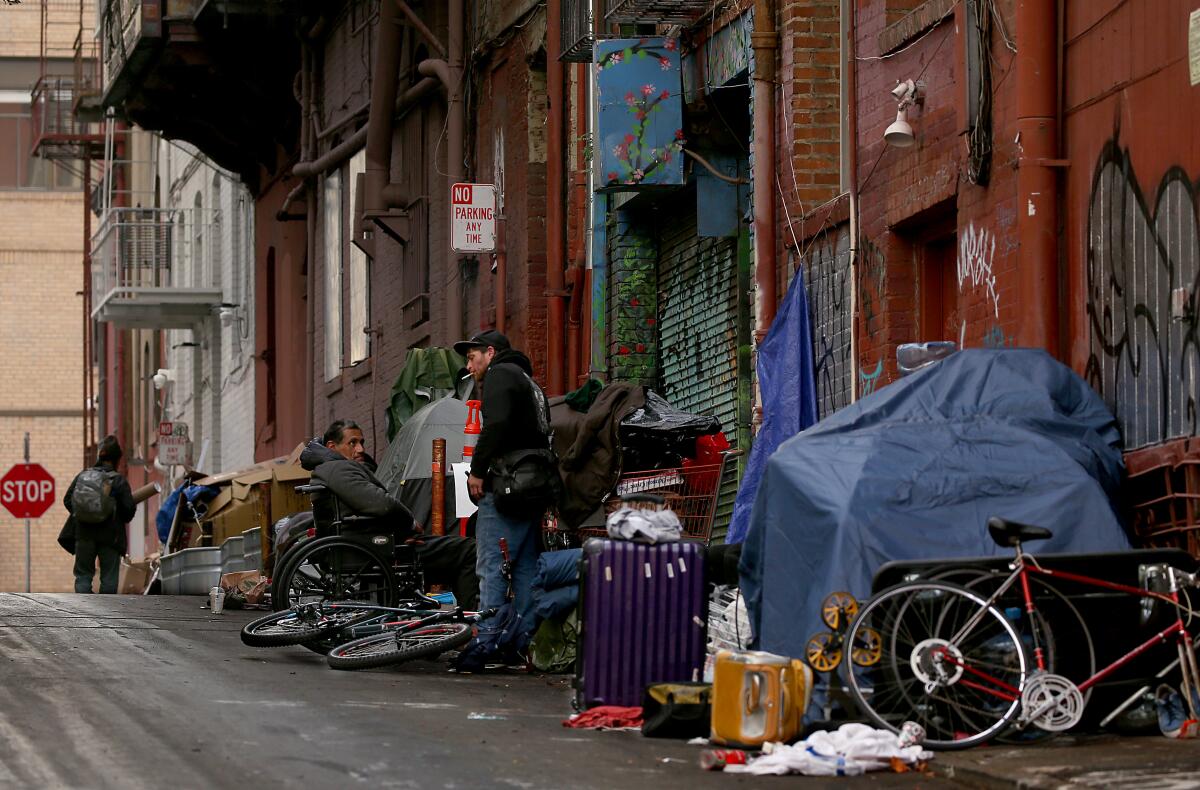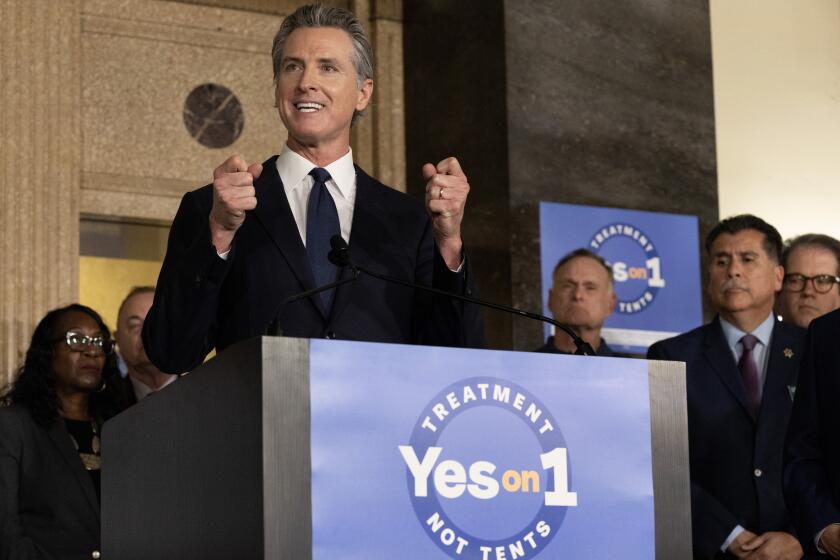Column: Credit Newsom for trying to alleviate homelessness, not that he has much choice

SACRAMENTO â Gov. Gavin Newsomâs âtreatment not tentsâ ballot measure would make only a puny dent in homelessness. But itâs still the biggest attempt ever by a California governor to address the growing problem.
Proposition 1 on the March 5 primary election ballot basically would shift current mental health funding to prioritize treatment for homeless people with mental illnesses or drug and alcohol addictions. It also would authorize selling $6.38 billion in bonds to build mental health treatment facilities and housing for homeless people while undergoing treatment.
Heâs the governor. He owns the problem. Itâs his duty to lead the resolution effort. And he has tried. But on his watch, homelessness has only gotten worse.
There were 151,000 homeless Californians when Newsom became governor in 2019. At last count, there were 181,000. Thatâs 28% of the nationâs total homeless population.
Newsom has national political ambitions. Having been governor of Americaâs homeless capital would not be a good talking point in a 2028 presidential race. But thereâs opportunity here too: He could show the rest of America how to control homelessness â even reduce it.
But letâs face facts: The biggest dilemma for solving homelessness in California is the extraordinarily high cost of housing in this overpopulated state. The average California home costs more than twice the national average. The median California home price soared above $800,000 last year.
Californiaâs homelessness and mental health crisis is so dire that Republicans and Democrats are leaving their ideological corners and stepping into an unfamiliar middle ground to try to solve the problem.
Thereâs a shortage of supply to meet the high demand. Blame land costs, pokey permitting, often-legitimate environmental concerns, dragged-out litigation and NIMBYism (not in my backyard).
Low-income renters have it particularly tough, many spending more than half their pay on housing. If they lose their job, thereâs no recourse but a family member or friendâs couch, the old car or the street.
The governor and the Legislature have been chipping away at regulatory red tape that slows housing construction and increases costs, but progress has been minimal. Public policy changes donât get implemented overnight.
Newsom has talked a good game on homelessness â and taken several meaningful actions, spending 10s of billions âeven as the problem worsens.
Moments after being sworn in as governor, the former San Francisco mayor lamented âa homeless epidemic that should keep each and every one of us up at night.â
In February 2020, Newsom devoted his entire State of the State address to homelessness. That was unprecedented.
âThe public has lost patience. You have all lost patience,â he told legislators. âAnd I have lost patience. ... I know homelessness can be solved. This is our calling.â
With Proposition 1, Newsom is trying to focus on unsheltered people with mental illnesses or addiction problems and bring as many as possible under a roof. It wouldnât be many.
The legislative analyst, writing in the stateâs official votersâ guide, reports that 4,350 housing units would be created, slightly more than half of them for veterans. There would also be new treatment facilities for 6,800 people. Newsom has hyped the housing number higher, but Iâll go with the impartial analystâs figures.
âThe number of housing units built by the bond would reduce statewide homelessness by only a small amount,â the analyst writes.
Gov. Gavin Newsom crafted the measure to reform Californiaâs mental health system, including a $6.4-billion bond for new facilities.
But if it reduced the number at all, that would be significant progress.
We need to recollect the past.
Much of todayâs dilemma results from Gov. Ronald Reagan and the Legislature closing state mental hospitals 57 years ago. They dumped patientsâ care onto the counties. But little money was provided for treatment. Many former patients self-medicated with drugs and alcohol and wound up on the street.
The problem was ignored by state and local governments for decades.
But Democrat Darrell Steinberg of Sacramento focused on mental illness after being elected to the state Assembly in the 1990s. In 2004, he successfully sponsored a ballot initiative that raised taxes by 1 percentage point on incomes above $1 million to raise money for local mental health treatment.
It was called the Mental Health Services Act â or, unofficially, the millionairesâ tax. And that is what Newsom is trying to amend to place more emphasis on treating the mentally ill or addicted who have fallen through the cracks .
âWe canât continue to do what weâve done,â Newsom asserts.
Steinberg, who later became state Senate leader and currently is Sacramentoâs mayor, embraces the governorâs proposed altering of his old initiative.
âIn 2004, I thought I wrote the perfect law,â Steinberg says. âBut after 20 years, itâs really important to take a look at these laws and initiatives and update them.â
The millionairesâ tax now raises about $3.5 billion annually. Practically all the money goes to the counties.
Californiaâs primary election takes place on March 5. Read up on the races in L.A. city, L.A. County and other areas.
âCounties have spent the money well,â Steinberg says. âBut they havenât spent enough on the people who are the sickest of the sick. And those are the people living in squalor on the streets.â
Polls show Proposition 1 passing by a large margin and Newsom is expected to spend well over $10 million to make sure it does. Opponents have only a few hundred dollars to press their argument that the measure basically robs Peter to pay Paul.
Lots of other mental health treatment programs would lose funding to pay for Newsomâs priorities, they assert. And theyâre right.
Steinberg says they can tap into other government money for mental health treatment.
Newsomâs proposal is no cure-all. But itâs better than a Band-Aid. Itâs treatment for those who need it most. And itâs worth trying.
More to Read
Sign up for Essential California
The most important California stories and recommendations in your inbox every morning.
You may occasionally receive promotional content from the Los Angeles Times.














